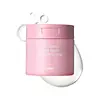What's inside
What's inside
 Key Ingredients
Key Ingredients

 Benefits
Benefits

 Concerns
Concerns

 Ingredients Side-by-side
Ingredients Side-by-side

Beta Vulgaris Root Extract
Skin ConditioningWater
Skin ConditioningDipropylene Glycol
HumectantMethylpropanediol
SolventButylene Glycol
Humectant1,2-Hexanediol
Skin ConditioningTheobroma Cacao Seed Extract
AntioxidantGardenia Florida Fruit Extract
Skin ConditioningPanthenol
Skin ConditioningTrehalose
HumectantDisodium EDTA
Xanthan Gum
EmulsifyingTromethamine
BufferingGluconolactone
Skin ConditioningAllantoin
Skin ConditioningGlycolic Acid
BufferingDextrin
AbsorbentCyanocobalamin
Skin ConditioningSalicylic Acid
MaskingHydroxyacetophenone
AntioxidantBeta Vulgaris Root Extract, Water, Dipropylene Glycol, Methylpropanediol, Butylene Glycol, 1,2-Hexanediol, Theobroma Cacao Seed Extract, Gardenia Florida Fruit Extract, Panthenol, Trehalose, Disodium EDTA, Xanthan Gum, Tromethamine, Gluconolactone, Allantoin, Glycolic Acid, Dextrin, Cyanocobalamin, Salicylic Acid, Hydroxyacetophenone
Water
Skin ConditioningBacillus Ferment Filtrate
Skin ConditioningButylene Glycol
HumectantIsopentyldiol
Humectant1,2-Hexanediol
Skin ConditioningOpuntia Ficus-Indica Stem Extract
Skin ConditioningOpuntia Ficus-Indica Flower Extract
Skin ConditioningOpuntia Ficus-Indica Seed Oil
EmollientTheobroma Cacao Seed Extract
AntioxidantCeramide NP
Skin ConditioningPhytosphingosine
Skin ConditioningAllantoin
Skin ConditioningPanthenol
Skin ConditioningArginine
MaskingAdenosine
Skin ConditioningHydrolyzed Jojoba Esters
Skin ConditioningHydrolyzed Sclerotium Gum
HumectantGlycerin
HumectantTocopherol
AntioxidantHydrogenated Lecithin
EmulsifyingEthylhexylglycerin
Skin ConditioningSodium Phytate
Dipropylene Glycol
HumectantPolyglyceryl-10 Laurate
Skin ConditioningBetaine
HumectantCarbomer
Emulsion StabilisingCaffeine
Skin ConditioningParfum
MaskingWater, Bacillus Ferment Filtrate, Butylene Glycol, Isopentyldiol, 1,2-Hexanediol, Opuntia Ficus-Indica Stem Extract, Opuntia Ficus-Indica Flower Extract, Opuntia Ficus-Indica Seed Oil, Theobroma Cacao Seed Extract, Ceramide NP, Phytosphingosine, Allantoin, Panthenol, Arginine, Adenosine, Hydrolyzed Jojoba Esters, Hydrolyzed Sclerotium Gum, Glycerin, Tocopherol, Hydrogenated Lecithin, Ethylhexylglycerin, Sodium Phytate, Dipropylene Glycol, Polyglyceryl-10 Laurate, Betaine, Carbomer, Caffeine, Parfum
 Reviews
Reviews

Ingredients Explained
These ingredients are found in both products.
Ingredients higher up in an ingredient list are typically present in a larger amount.
1,2-Hexanediol is a synthetic liquid and another multi-functional powerhouse.
It is a:
- Humectant, drawing moisture into the skin
- Emollient, helping to soften skin
- Solvent, dispersing and stabilizing formulas
- Preservative booster, enhancing the antimicrobial activity of other preservatives
Allantoin is a soothing ingredient known for its protective and moisturizingg properties. Because of this, it is often added to products with strong active ingredients.
Studies show higher concentrations of this ingredient can promote wound healing.
Though it can be derived from the comfrey plant, allantoin is produced synthetically for cosmetic products to ensure purity.
Learn more about AllantoinButylene Glycol (or BG) is used within cosmetic products for a few different reasons:
Overall, Butylene Glycol is a safe and well-rounded ingredient that works well with other ingredients.
Though this ingredient works well with most skin types, some people with sensitive skin may experience a reaction such as allergic rashes, closed comedones, or itchiness.
Learn more about Butylene GlycolDipropylene Glycol is a synthetically created humectant, stabilizer, and solvent.
This ingredient helps:
Dipropylene glycol is technically an alcohol, but it belongs to the glycol family (often considered part of the ‘good’ alcohols). This means it is hydrating and gentle on skin unlike drying solvent alcohols like denatured alcohol.
As a masking agent, Dipropylene Glycol can be used to cover the smell of other ingredients. However, it does not have a scent.
Studies show Dipropylene Glycol is considered safe to use in skincare.
Learn more about Dipropylene GlycolPanthenol is a common ingredient that helps hydrate and soothe the skin. It is found naturally in our skin and hair.
There are two forms of panthenol: D and L.
D-panthenol is also known as dexpanthenol. Most cosmetics use dexpanthenol or a mixture of D and L-panthenol.
Panthenol is famous due to its ability to go deeper into the skin's layers. Using this ingredient has numerous pros (and no cons):
Like hyaluronic acid, panthenol is a humectant. Humectants are able to bind and hold large amounts of water to keep skin hydrated.
This ingredient works well for wound healing. It works by increasing tissue in the wound and helps close open wounds.
Once oxidized, panthenol converts to pantothenic acid. Panthothenic acid is found in all living cells.
This ingredient is also referred to as pro-vitamin B5.
Learn more about PanthenolTheobroma Cacao Seed Extract comes from the Theobroma cacoa, or Cacao tree. Cacao trees are native to tropical landscapes.
Cacao seed extract contains antioxidants known as polyphenols.
Water. It's the most common cosmetic ingredient of all. You'll usually see it at the top of ingredient lists, meaning that it makes up the largest part of the product.
So why is it so popular? Water most often acts as a solvent - this means that it helps dissolve other ingredients into the formulation.
You'll also recognize water as that liquid we all need to stay alive. If you see this, drink a glass of water. Stay hydrated!
Learn more about Water